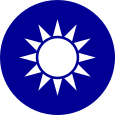Tangwai movement
You can help expand this article with text translated from the corresponding article in Chinese. (January 2016) Click [show] for important translation instructions.
|
| Tangwai movement | |
|---|---|
Tâi-lô | Tóng-guā |
 |
|---|
|
|
The Tangwai movement, or simply Tangwai (
History
This article is missing information about needs information from 1980-onwards. (March 2021) |
Early figures associated with the movement include Kang Ning-hsiang and Huang Hsin-chieh. College professors led a series of demonstrations and open demands for political change in city streets.[1] By 1973 the government began to arrest the leaders of this new movement and fire those professors who openly criticized the regime. While leading an authoritarian government, Chiang Ching-kuo appeared to be open minded to the possibility of political dissent.[1]
Because the majority of seats in the Legislative Yuan were held by delegates purportedly representing constituencies in mainland China, who were elected in 1947 and appointed thereafter (because the "electorate" in mainland China was unable to cast votes in an election in the Taiwan Area), pending the promised retaking of mainland China, the tangwai movement had no possibility of gaining power. They were, however, able to use the legislature as a forum for debating the ruling KMT.
In response to more native Taiwanese taking public office, the tangwai attempted to contest elections in 1975-1976 and demand even more changes to the political system.
In 1979, the same year which the US ceased its recognition of the Republic of China, conflict between authorities and the tangwai again turned violent in the
Throughout the 1980s the Chiang administration continued to limit free speech. On the other hand, scholars argue that the various other demonstrations by common citizens helped keep the tangwai movement alive despite the mass imprisonment of its leaders. Examples of other social movements from both the middle and working classes which who staged public demonstrations included farmers protesting against corporate farms, and environmentalists opposing a proposed factory from DuPont to be built in Lukang.
The Presbyterian Church of Taiwan was linked to many members of the Tangwai, and the Church itself was at the center of government censure for publishing works in Romanized Taiwanese Hokkien in the 1970s. The government confiscated these works, which led the Church to appeal to the Carter administration of the United States to highlight what it considered a human rights violation.
Efforts to counter the tangwai may have included the opening of the political system to Taiwanese who did not hold radical beliefs. Various individuals helped recruit intellectuals to work within the Kuomintang. Sung Shih-hsuan, then chairman of the Provincial Party Committee, introduced social service orientation to local party work, perhaps in an effort to counter the social activism of the Presbyterian Church and Maryknoll order.
Members of the Tangwai movement formed the Democratic Progressive Party (DPP) in 1986.[5] Although still illegal, the KMT did not take action against the DPP and the party was legalized in 1991. Many current politicians in Taiwan, most notably former President Chen Shui-bian and Vice President Annette Lu, were active in the tangwai movement.[6]
Tangwai members, including Shih Ming-teh and Lin Yi-hsiung, were often harassed or imprisoned by the KMT government, especially in the wake of the Kaohsiung Incident.
See also
References
- ^ a b c Rubenstein 2014, p. 439.
- ^ Rubenstein 2014, p. 441.
- ^ Rubenstein 2014, p. 442.
- ^ Rubenstein 2014, p. 443.
- .
- ^ "CityU Institutional Repository: Taiwan's democratic transition : a critical examination of its open-up". dspace.cityu.edu.hk. Archived from the original on 2014-08-27.
Bibliography
- Rubenstein, Murray A. (2014). Taiwan: A New History. Taylor & Francis.

